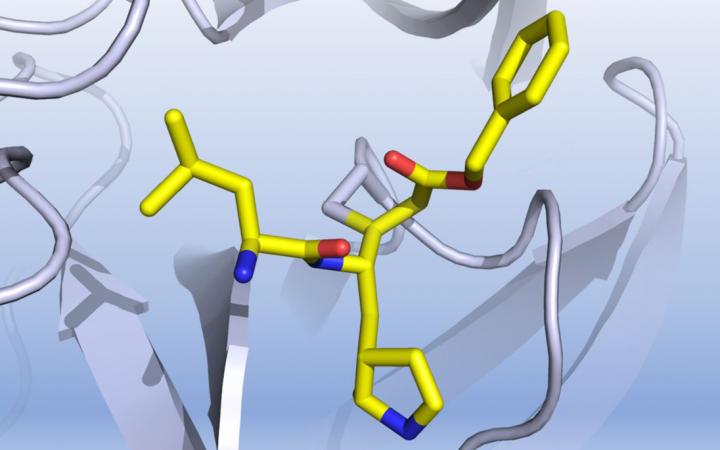The SARS-CoV-2 viral genome encodes for 29 proteins—many of which could serve as potential targets for anti-viral drugs. In order to rapidly discover lead compounds for clinical use in the fight against COVID-19, an international team of scientists used a combination of approaches including structure-assisted drug design, virtual drug screening, and high-throughput screening.
The researchers used computer-aided drug design to identify N3—a mechanism-based inhibitor of the main protease (Mpro) of SARS-CoV-2. The team went on to describe a high-resolution crystal structure of Mpro in complex with N3. Once they had this structure, they could use it as a model to identify more lead Mpro inhibitors. They then tested more than 10,000 compounds using a FRET assay to identify six drug candidates that target Mpro and may hold promise in combating COVID-19.
Viral RNA is translated into a long polypeptide that includes multiple, distinct proteins. The protease must cut the polypeptide into functional proteins. Mpro digests the polyprotein at “no less than 11 conserved sites,” according to the authors of the paper.
The pivotal role of Mpro in mediating viral replication and transcription makes it “an attractive drug target for this virus,” noted Luke Guddat, PhD, professor at the University of Queensland and author on the paper. Because the enzyme is not found in people, “compounds that target it are likely to have low toxicity.” Guddat continued, “We add the drugs directly to the enzyme or to cell cultures growing the virus and assess how much of each compound is required to stop the enzyme from working or to kill the virus. If the amount is small, then we have a promising compound for further studies.”
The work is published in Nature, in the paper titled, “Structure of Mpro from COVID-19 virus and discovery of its inhibitors.” The authors consisted of researchers from multiple Chinese institutions including Shanghai Tech University in Shanghai, Tsinghua University in Beijing, Chinese Academy of Sciences in Wuhan, Nankai University in Tianjin, and the University of Queensland, in Brisbane, Australia.
“Currently there are no targeted therapeutics or effective treatment options for COVID-19,” said Guddat. “In order to rapidly discover lead compounds for clinical use, we initiated a program of high-throughput drug screening, both in laboratories and also using the latest computer software to predict how different drugs bind to the virus.”
The scientists assayed over 10,000 compounds, including approved drugs, drug candidates in clinical trials, and other pharmacologically active compounds, as potential inhibitors of Mpro. After assaying thousands of drugs, researchers found six that appeared to be effective in inhibiting the enzyme. The six compounds are ebselen, disulfiram, tideglusib, carmofur, shikonin, and PX-12. The compound ebselen also exhibited promising antiviral activity in cell-based assays.
The authors write that, since their structural data is based on N3, they “investigated if molecular docking could predict how disulfiram, tideglusib, and shikonin bind to this protein.” In all cases, they reported, “reasonable docking poses were found, demonstrating that they could fit inside the substrate-binding pocket.”
“The team is particularly interested in several leads that have been subjected to clinical trials including for the prevention and treatment of various disorders such as cardiovascular diseases, arthritis, stroke, atherosclerosis, and cancer,” Guddat said. Compounds that are already along the pipeline to drug discovery are preferred, as they can be further tested as antivirals at an accelerated rate compared to new drug leads that would have to go through this process from scratch.
The results, the authors noted, “demonstrate the efficacy of this screening strategy, which can lead to the rapid discovery of drug leads with clinical potential in response to new infectious diseases for which no specific drugs or vaccines are available.”
The team publicly released the list of candidate drugs—before publication—on January 25 and the structure of the COVID-19 virus Mpro on January 26, in advance of officially releasing the results. After the enzyme’s structure was made public, the team received more than 300 requests for more information.
“To provide an analogy, we’ve provided scientists with a fishing pole, the line, and the exact bait, and have in only one month caught some fish,” Guddat said. “Now it’s up to us and the other fisherman—our fellow scientists globally—to take full advantage of this breakthrough.” With continued and up-scaled efforts, he added, “we are optimistic that new candidates can enter the COVID-19 drug discovery pipeline in the near future.”



